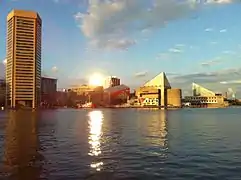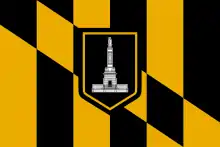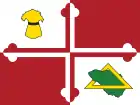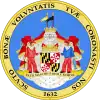Baltimore metropolitan area
The Baltimore–Columbia–Towson Metropolitan Statistical Area, also known as Central Maryland, is a Metropolitan Statistical Area (MSA) in Maryland as defined by the United States Office of Management and Budget (OMB). As of the 2010 Census, the combined population of the seven counties is 2,710,489. The MSA has the fourth-highest median household income in the United States, at $66,970 in 2012.[1]
Central Maryland Baltimore-Columbia-Towson Metropolitan Area | |
|---|---|
 | |
 Counties of the Baltimore-Columbia-Towson Metropolitan area highlighted in red. | |
| Country | United States |
| State | Maryland |
| Principal municipalities | Baltimore, Columbia, Towson |
| Population (2014) | |
| • Metropolitan area | 2,710,489 (20th) |
| • Urban | (19th) |
| • Urban density | 1,038.9/sq mi (401.1/km2) |
| • CSA | 9,331,587 (4th) |
| MSA = 2014, CSA = 2012, Urban & Densities = 2010 | |
| Time zone | UTC−5 (ET) |
| • Summer (DST) | UTC−4 (EST) |
Composition
The area includes the following counties:[2][3]
 Anne Arundel County
Anne Arundel County Baltimore City
Baltimore City Baltimore County
Baltimore County Carroll County
Carroll County Harford County
Harford County Howard County
Howard County- Queen Anne's County
| County | 2016 Estimate | 2010 Census | Change | Area | Density |
|---|---|---|---|---|---|
| Anne Arundel County | 568,346 | 537,656 | +5.71% | 414.90 sq mi (1,074.6 km2) | 1,370/sq mi (529/km2) |
| Baltimore County | 831,026 | 805,029 | +3.23% | 598.30 sq mi (1,549.6 km2) | 1,389/sq mi (536/km2) |
| Baltimore City | 614,664 | 620,961 | −1.01% | 80.94 sq mi (209.6 km2) | 7,594/sq mi (2,932/km2) |
| Carroll County | 167,656 | 167,134 | +0.31% | 447.59 sq mi (1,159.3 km2) | 375/sq mi (145/km2) |
| Harford County | 251,032 | 244,826 | +2.53% | 437.09 sq mi (1,132.1 km2) | 574/sq mi (222/km2) |
| Howard County | 317,233 | 287,085 | +10.50% | 250.74 sq mi (649.4 km2) | 1,265/sq mi (488/km2) |
| Queen Anne's County | 48,929 | 47,798 | +2.37% | 371.91 sq mi (963.2 km2) | 132/sq mi (51/km2) |
| Total | 2,798,886 | 2,710,489 | +3.26% | 2,601.47 sq mi (6,737.8 km2) | 1,076/sq mi (415/km2) |
| Historical populations | |||
|---|---|---|---|
| Census | Pop. | %± | |
| 1820 | 96,201 | — | |
| 1830 | 120,870 | 25.6% | |
| 1840 | 134,379 | 11.2% | |
| 1850 | 210,646 | 56.8% | |
| 1860 | 266,553 | 26.5% | |
| 1870 | 330,741 | 24.1% | |
| 1880 | 415,649 | 25.7% | |
| 1890 | 507,348 | 22.1% | |
| 1900 | 639,332 | 26.0% | |
| 1910 | 720,387 | 12.7% | |
| 1920 | 852,051 | 18.3% | |
| 1930 | 984,606 | 15.6% | |
| 1940 | 1,083,300 | 10.0% | |
| 1950 | 1,337,373 | 23.5% | |
| 1960 | 1,820,314 | 36.1% | |
| 1970 | 2,089,092 | 14.8% | |
| 1980 | 2,199,531 | 5.3% | |
| 1990 | 2,382,172 | 8.3% | |
| 2000 | 2,552,994 | 7.2% | |
| 2010 | 2,710,489 | 6.2% | |
| 2019 (est.) | 2,800,053 | [4] | 3.3% |
| U.S. Decennial Census[5] 1790–1960[6] 1900–1990[7] 1990–2000[8] | |||
Principal cities
The metropolitan area includes the following principal communities :
It also includes several other communities (not necessarily incorporated as cities or towns):
- Aberdeen
- Annapolis
- Bel Air
- Catonsville
- Dundalk
- Eldersburg
- Ellicott City
- Edgewood
- Glen Burnie
- Hanover
- Havre de Grace
- Jessup
- Joppatowne
- Owings Mills
- Westminster
In addition to its technical metropolitan area, Baltimore also receives a large number of commuters from cities such as York, Pennsylvania[9] and the Washington Metropolitan Area.
History
Companies in metropolitan Baltimore
Greater Baltimore (the city and surrounding suburbs in Baltimore County) is home to four Fortune 1000 companies: Grace Chemicals (in Columbia), Legg Mason, T. Rowe Price, and McCormick & Company (in Hunt Valley). Other companies that call Greater Baltimore home include AAI Corporation (in Hunt Valley), Adams Express Company, Brown Advisory, Alex Brown, First Home Mortgage Corporation, FTI Consulting, Petroleum & Resources Corporation, Vertis, Prometric, Sylvan Learning, Laureate Education, Under Armour, Polk Audio, DAP, 180s, DeBaufre Bakeries, Wm. T. Burnett & Co, Old Mutual Financial Network, Firaxis Games (in Sparks), Sinclair Broadcast Group (in Hunt Valley), Fila USA (in Sparks), and JoS. A. Bank Clothiers (in Hampstead).
Government and infrastructure
The capital of Maryland and the agencies of the Maryland state government are located in the Baltimore MSA, mainly in Annapolis and Baltimore City. The area is also home to the National Security Agency (NSA) headquarters in Fort Meade in Anne Arundel County, as well as the Social Security Administration and the Centers for Medicare & Medicaid Services (CMS) in Woodlawn in Baltimore County.
Sports teams in metropolitan Baltimore
- Baltimore Orioles – Major League Baseball (since 1954)
- Baltimore Ravens – National Football League (since 1996)
- Baltimore Blast – Major Arena Soccer League (since 2014)
- Baltimore Brigade – Arena Football League (since 2017)
- Baltimore Burn – Women's Spring Football League (since 2001)
- Baltimore Nighthawks – Independent Women's Football League (since 2008)
- Charm City Roller Girls – Women's Flat Track Derby Association (since 2006)
- Coppin State Eagles
- Johns Hopkins Blue Jays, competes in Division I for men's and women's lacrosse only
- Loyola Greyhounds
- Morgan State Bears
In Baltimore County:
In Anne Arundel County:
- Navy Midshipmen, in Annapolis
- Chesapeake Bayhawks, in Annapolis
- Maryland Black Bears, in Odenton
Notes
- Noss, Amanda (September 2013). Household Income: 2012 (PDF) (Report). American Community Survey Briefs. Archived from the original (PDF) on December 3, 2017.
- "Current Employment Statistics (CES) Metropolitan Area Definitions". Bureau of Labor Statistics. November 14, 2005. Archived from the original on September 7, 2008.
- "MSA Bulletin 2003 Attachment, Revised 07/07/03" (PDF). Office of Management and Budget. Archived (PDF) from the original on February 27, 2008.
- "Population and Housing Unit Estimates". Retrieved May 10, 2019.
- "U.S. Decennial Census". United States Census Bureau. Retrieved May 18, 2014.
- "Historical Census Browser". University of Virginia Library. Retrieved May 18, 2014.
- "Population of Counties by Decennial Census: 1900 to 1990". United States Census Bureau. Retrieved May 18, 2014.
- "Census 2000 PHC-T-4. Ranking Tables for Counties: 1990 and 2000" (PDF). United States Census Bureau. Retrieved May 18, 2014.
- Berman, Dori (2006). "Commuter bus line may link York, Pa. and Hunt Valley". The Daily Record. Archived from the original on September 19, 2008.
